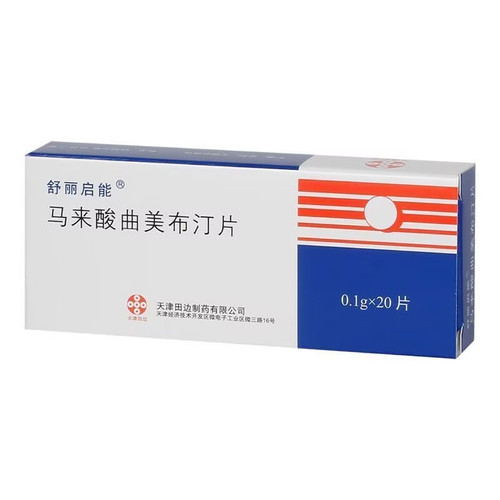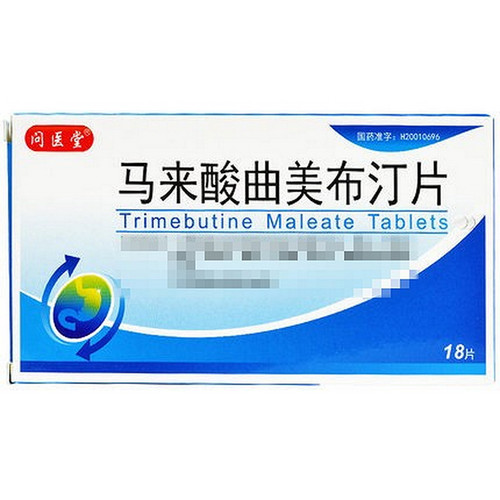Product Overview
[Drug Name]
Trade Name: Nuowei
English Name: Trimebutine Maleate Tablets
Chinese Pinyin: Malaisuan Qumeibuting Pian
[Ingredients]
Trimebutine maleate
[Properties]
This product should be white or off-white tablets.
[Indications]
(1) Improvement of symptoms such as loss of appetite, nausea, vomiting, belching, abdominal distension, abdominal borborygmus, abdominal pain, diarrhea and constipation caused by gastrointestinal motility disorders.
(2) Irritable bowel syndrome.
[Usage and Dosage]
Oral administration, 100-200 mg each time, 3 times a day. The dose can be appropriately increased or decreased according to age and symptoms, or as directed by a doctor.
[Adverse Reactions]
Occasional reactions include thirst, oral numbness, abdominal borborygmi, abdominal distension, constipation, tachycardia, drowsiness, dizziness, headache, rash, and elevated levels of glutamic-oxalyl aminotransferase (GOT) and alanine aminotransferase (GPT), with an incidence of approximately 0.4%.
[Contraindications]
This product is contraindicated in patients allergic to trimebutine maleate.
[Precautions]
Patients who develop a rash should discontinue the drug and undergo observation.
[Use in Special Populations]
Precautions for Children: Use with caution in children.
Precautions for Pregnancy and Lactation: Use with caution in pregnant and lactating women.
Precautions for the Elderly: Elderly individuals generally have weaker physiological functions, so a reduced dosage is recommended.
[Drug Interactions]
Combined use with proton pump inhibitors accelerates ulcer healing.
[Pharmacological Actions]
1. Gastric Motility Modulation: Addition of 10-5 g/ml of this product to isolated guinea pig gastric vestibular circular muscle specimens reduces the amplitude of its autonomic movements. In addition, it can also increase the frequency and amplitude of irregular weak movements in the same specimen at 28°C, causing them to tend toward regular rhythmic contractions. When 3 mg/kg of this drug is administered intravenously to anesthetized dogs with severed thoracic vagus nerves, irregular gastric movements tend to become regular. In patients with digestive system diseases, intravenous injection of 1 mg/kg of this drug has been found to inhibit the movement of hyperkinetic muscles and enhance the movement of hypokinetic muscles. 2. Inducing propulsive movements of the digestive tract system: Intrajejunal administration of 4-6 mg/kg has been found to induce physiological propulsive movements of the adult digestive system. 3. Improving gastric emptying function: In patients with chronic gastritis and frequent, unexplained upper abdominal gastrointestinal discomfort, oral administration of 200 mg of this drug can improve decreased gastric emptying function and inhibit hyperactive gastric emptying function. Regulating Intestinal Motility: In experiments on isolated guinea pig colon specimens, a concentration of 10-5 g/ml increased muscle tone (under low load) and reduced muscle tone and amplitude (under high load). This product can also suppress the hypermotility of the large intestine caused by psychological exertion in allergic bowel syndrome. Taking 300 mg of this product can also suppress this. In patients with neostigmine-induced hypermotility, intravenous administration of 50 mg can inhibit motility in the ileum, ascending colon, and sigmoid colon to pre-load levels. 5. Regulating Lower Esophageal Sphincter Pressure (LESP) Experiments on lower esophageal sphincter pressure in anesthetized dogs showed that intravenous administration of 0.6 mg/kg reduced the increase in LESP induced by tetragastrin loading and also reversed the decrease in LESP induced by secretin. 6. Direct Effects on Digestive Tract Smooth Muscle Experiments on isolated guinea pig gastric vestibular circular muscle specimens revealed that this product maintained direct effects on digestive tract smooth muscle even in the presence of atropine, phentolamine, propranolol, and tetrodotoxin. Experiments on isolated guinea pig ileum revealed that this product non-competitively inhibited contractions induced by acetylcholine. It was also found that thoracic vagus nerve resection in anesthetized dogs still had a direct effect on gastrointestinal motility. 7. Peripheral Antiemetic Effect: Experiments in dogs found that while the inhibitory effect on apomorphine-induced vomiting was weak, intravenous injection of 3 mg/kg or oral administration of 60 mg/kg of this product significantly prolonged the duration of vomiting induced by copper sulfate.
[Storage]
Store in a dark, airtight container.
[Specification]
0.2g
[Packaging]
Aluminum-plastic packaging, 24 tablets per box
[Expiry Date]
24 months
[Approval Number]
National Medicine Standard No. H20040438
[Manufacturer]
Company Name: Hainan Puli Pharmaceutical Co., Ltd.






